related pages:

|
- introduction
amiens
- museum
of stone carving
recumbent bronzes
the labyrinth
damage
in world war 1
the
choir stalls of amiens cathedral
the
stained glass at amiens
buttressing and chainage
- beauvais
- some
history and interesting facts
world war
2 damage
glass at beauvais
- bibliography
end notes
Just as in the modern age, where
every ambitious builder in New York strove to build an
ever higher skyscraper, a vanity that now has spread around
the world, the cities of France sought to outdo their
rivals with ever bigger and taller cathedrals.
During the great cathedral-building craze, the vaults at Laon rose to 79 feet/24 m, those at Paris managed 110
feet/33.5 m, Chartres 114 feet/34.75 m, then 125 feet/38
m at Reims, then another leap to 135 feet/41.2 m at Amiens,
and finally Beauvais hit the sky at 157 feet 6 inches/48
m - the only trouble was, they never could quite manage
to make it stay up - the winner.
Biggest, longest, tallest, fattest, a lot of the time
it depends on what and how you measure. Outside or inside,
a chapel that has been added or that spire anybody can
build on top, like a flagpole or aerial on a skyscraper.
The Great Pyramid rose to a bit over 145 metres, but has
lost about 10 metres as it has eroded down the ages. |
|
Various European spires ran up above 150 metres while
in France, Rouen topped 150 metres in the 19th century
with a cast iron version was added. The age of iron and
steel frames was upon us, the Eiffel Tower reaching 320
metres in 1889. But between the pyramids and the age of
iron and steel, the cathedrals were the tallest structures
in the world.
While Beauvais built higher, Amiens built bigger. It
is said that Amiens cathedral was able to accommodate
the whole 10,000 population of the medieval town. |
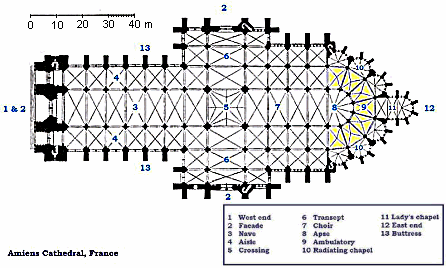
Above: Plan of Amiens cathedral.
The building covers an area of 7,700 m².
Its internal volume is 200,000 m³.
right: Beauvais cathedral looms over the surrounding streets. |
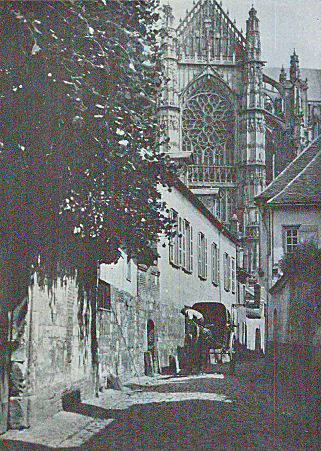 |
|
|
new :
on first arriving
in France - driving

France is not
England
Marianne - a French
national symbol, with French definitive stamps
the calendar
of the French Revolution

the
6th bridge at Rouen: Pont Gustave Flaubert,
new vertical lift bridge

Futuroscope
Vulcania
the French
umbrella & Aurillac
the
forest in Aquitaine, as seen by francois mauriac, and
today 
places
and playtime
roundabout
art of Les Landes

50 years
old: Citroën
DS
the Citroën
2CV:
a French
motoring icon
la
belle époque 
Pic
du Midi - observing stars clearly, A64 
Carcassonne,
A61: world heritage fortified city 
Grand Palais,
Paris
mardi gras! carnival
in Basque country
what a hair cut! m
& French pop/rock
country life
in France: the poultry fair
short
biography of Pierre (Peter) Abelard
Grand Palais,
Paris
dating old
postcards
bastide towns
the greatest show
on Earth - the Tour de France
Futuroscope
Vulcania
Space City, Toulouse

|
La cathedrale d'Amiens
The west front of Amiens cathedral is sometimes considered the
most perfect and complete gothic facade. My first impression
on mounting the parvis of Amiens is almost confusion,
with the surfeit of carven stone bodies. I don’t
much like crowds, and west front is like a crowd when
first seen. It is over time that the more interesting
details are gradually comprehended.
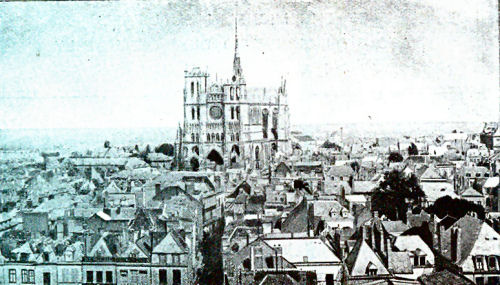
Panorama of Amiens (19th century)
museum
of stone carving
the
recumbent bronzes
“Two remarkable monuments of bronze, at the entrance
of the nave from the western porch, were erected in
memory of the founders of the church, Bishops Evrard
and Gaudefroy. Upon the cenotaph of Evrard, the bishop
is represented giving his benediction and trampling
under his feet two dragons; round the tomb is a leonine
inscription in Lombardic characters. The cenotaph of
Bishop Gaudefroy d'Eu, on the opposite side of the entrance,
and of the same material, differs little in its design
and execution from that of Evrard. Both monuments were
formerly placed in the middle of the nave, but were
removed to the present site in 1762. Monuments of bronze
are extremely rare in France, in consequence of the
desecration of the churches of this kingdom during the
eventful revolution of 1789.”
[p. 23, French
cathedrals by Benjamin Winkles, Robert Garland,
1837]
 |
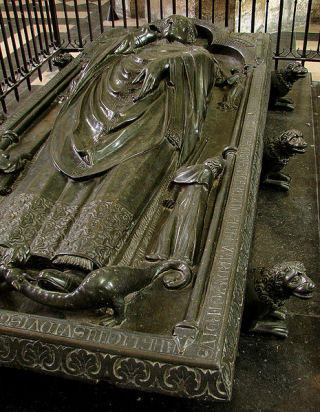 |
| Bronze memorial to
Bishop Geoffroy |
Bronze memorial
to Bishop Evrard |
Around the edge of each gisant (recumbent) statue
is a dedication.
That of Bishop Everard de Fouilloy
(died 1222) has engraved this inscription :
“Qui populum pavit, qui fundamêta locavit
Huiûs structure, cuius fuit urbs data cure
Hic redolens nardus famâ, requiescit Ewardus,
Vir pius ahflictos, vidvis tutela, relictis
Custos, quos poterat recreabat munere ; ύbis
Mitib aguus erat, tumidis leo, lima supbis”

|
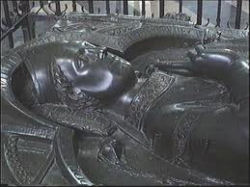 |
“Who fed the people, who laid
the foundations of this
Structure, to whose care the City was given,
Here, in ever-breathing balm of fame, rests Everard.
A man compassionate to the afflicted, the widow’s
protector, the orphan’s
Guardian. Whom he could, he recreated with gifts.
To words of men,
If gentle, a lamb ; if violent, a lion ; if proud,
biting steel.” [John Ruskin] |
That for Geoffroy d’Eu (died 1237) :
“Ecce premunt humile Gaufridi membra cubile.
Seu minus aut simile nobis parat omnibus ille ;
Quem laurus gemina decoraverat, in medicinâ
Lege qû divina, decuerunt cornua bina ;
Clare vir Augensis, quo sedes Ambianensis
Crevit in imensis ; in cœlis auctus, Amen,
sis.”
[Note this is in rhyming couplets.]

|
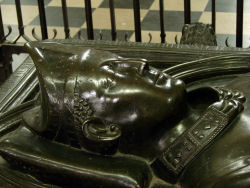 |
“Behold, Geoffrey’s limbs
are pressing his humble bed.
Whether less, or like us, he is preparing for all;
Whom the twin laurels adorn, in medicine
And the divine law, the
glory of two horns;
Illustrious man of Eu, whose see is Amiens,
Grew in stature; increased in heaven, Amen, if you
wish.” |
“The labyrinths of Rheims,
Chartres, and Amiens possessed in common a feature
which has given rise to much discussion, namely, a
figure or figures at the centre representing, it is
believed, the architects of the edifices.
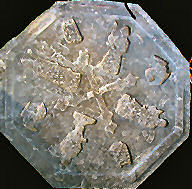
Original central medallion of Amiens Labyrinth
“That of Amiens is preserved in Amiens Museum
and consists of an octagonal grey marble slab with
a central cross, between the limbs of which are arranged
figures representing Bishop Evrard and the three architects,
Robert de Luzarches, Thomas de Cormont and his son
Regnault, together with four angels. A long inscription
accompanied it, relating to the foundation of the
Cathedral.” [Quoted from sacred-texts.com]
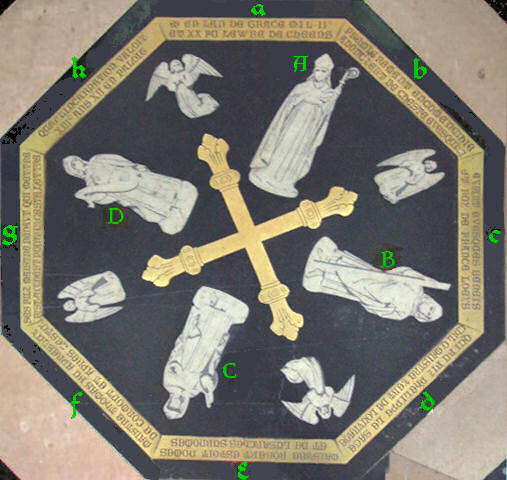
Reconstruction of the central medallion in the original Amiens labyrinth, now part of the current labyrinth
A : Bishop
Evrard de Fouilloy +1222
B : Architect Maïtre
Robert de Luzarches +1223
C : Architect Maïtre
Thomas de Cormont +1240
D : Architect Maitre Renaut
de Cormont
a : En l'an
de grâce mil II.c
Et XX fu l'œuvre de cheens |
In the year of grace thousand two hundred
And twenty was this work |
b : Premièrement
en comenchie
A dont yert de cheste Evesquie |
First begun
The bishop of this diocese was |
c : EVRART Evesques benis
Et Roy de France Loys. |
Evrard blessed Bishop and the
King of France was Louis [VIII] |
d : Q. fu
filz Phelippe Lesage
Chil. Q. maistre yert de l'œuvre |
Who was son of Philip the Wise
He who was master of the work |
e : Maistre
Robert estoit nomes
Et de Lusarches surnomes. |
Was named Master Robert and
surnamed de Luzarches. |
f : Maistre
Thomas fu après luy
De Cormot. Et après sen filz |
Master Thomas de Cormont was
after him. And afterwards his son |
g : Maistre
Regnault qui master
Fist à chest point Chichester lecture |
Master Renaut who had
placed at this spot |
h : Que
reincarnation valuate
Exilic an mains XII en Fallot. |
This inscription
in the year of incarnation 1288. |
“Evrard de Fouilloy, 45th bishop of
Amiens, placed the first stone of the cathedral of this
town in 1220, under the pontificate of Honour
III. The walls had hardly left the ground when he died.
Gaudefroy of Eu, his successor, raised the walls from
the cobble stones to the vaults. Bishop Arnoult constructed
the vaults, the galleries outside and a bell tower,
all of which no longer exists. At last, this beautiful
edifice was finished in 1288, with the exception of
the towers, which for lack of funds, were not finished
until the 14th century.
“Robert de Lusarches, the most famous architect
of the time, drew the plan of the cathedral and started
construction. After his death, Thomas de Cormont continued
the works and Renault, his son, finished them.
“This is what the following inscription describes,
an inscription on a copper strip at the centre of a
maze of blue and white stones that used to be in the
middle of the nave cobbles.”
[From Histoire
de la ville d'Amiens: depuis les Gaulois jusqu'en 1830 by Hyacinthe Duseve, 1835, vol. 1 pp. 174-6]
The original labyrinth at Amiens was constructed in 1288,
being 12.8 metres (42 feet) in diameter. It was destroyed in 1825. The drawing below appears to have been made before that labyrinth's destruction … or maybe not.
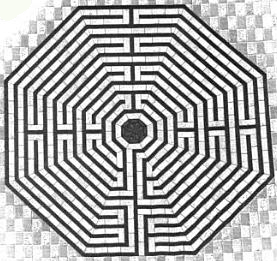
Original? Amiens labyrinth, drawn by Jules Gailhabaud [1810-1888],
in L'architecture
du 5me au 17me siècle et les arts qui en dépendent, Volume
2, 1858
(unpaginated book, about 3/4 of the way through)
The current labyrinth, restored in 1894, is in the nave between other tiling.
It is 12.1 metres in diameter. The design can be difficult to follow as chairs, billboards and
other church clutter tend to be put there willy-nilly. The labyrinth is made from black marble and Basz yellow-white tiles from Lunel. It is known here as the "House of Dedale".

Amiens labyrinth. Image: Maurice Duvanel
However, if you take the drawing by Gailhabaud (a bit above), and reverse it black to white and white to black (similarly to making a negative), and then flip that reversed image left to right, magically it becomes the pattern for the present Amiens labyrinth. However, as you can see, the actual Amiens labyrinth has a redundant and confusing black line surrounding it. |
| the labyrinth at Amiens cathedral |
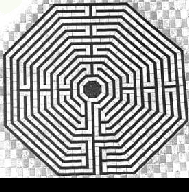 |
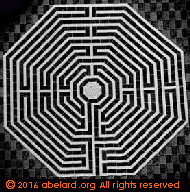 |
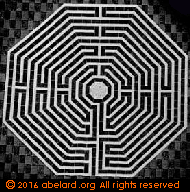 |
|
 |
| drawing by Gailhabaud, attributed by him to Amiens labyrinth |
made into a negative image |
flipped on the vertical axis |
|
photo of the actual labyrinth at Amiens |
The story then becomes stranger still. Gailhabaud shows the illustration, left below, for the labyrinth at Saint Quentin. This labyrinth illustration, in fact, corresponds to the actual labyrinth at Amiens (far right in the series above). It does not correspond to the actual labyrinth at Saint Quentin. To obtain the actual labyrinth at Saint Quentin, the Gailhabaud drawing must be flipped from left to right!
| the labyrinth at the basilica of Saint Quentin |
 |
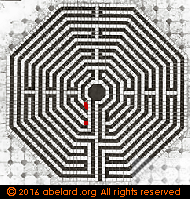 |
 |
Saint Quentin labyrinth, drawn by Gailhabaud
Note: the drawing has an error, missing two bars. abelard.org has added these bars in red.] |
flipped on the vertical axis |
photo of the actual labyrinth
at Saint Quentin |
|
| |
Damage
in World War 1
Amiens was near to, though not at, the First World War
front line. On 31 August 1914, forward units of the German
army entered Amiens, and immediately started their habitual
looting and bullying. During this, the Germans also kidnapped
about a thousand young men, sending them into captivity.
About a week later, they were forced to turn tail as
the main German offensive was blocked. They finally left
on 17 September (the defeat on the Marne).
On 21 March 1918, Ludendorff opened a great offensive
with a million troops, in order to break out. He was steadily
ground down and stopped, being unable to enter Amiens
but, of course, this did not stop the Germans from regularly
shelling the town. During this time, the cathedral was
hit nine times.
Without the Germans in the town, the people of Amiens
were able to heavily protect the cathedral inside and
out, and to remove the stained glass and other treasures
to safety. So while some damage was done to the cathedral,
it was minimised.
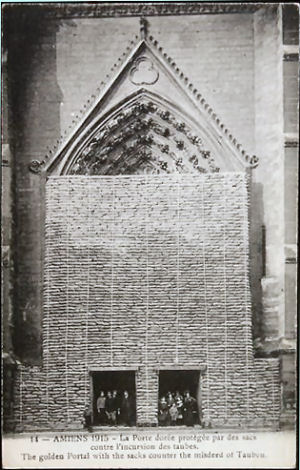
above: southern transept door,
the door of the golden Virgin, protected by sandbags,
1915 |
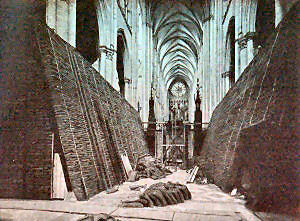 above:
the choir stalls protected by sandbagging. above:
the choir stalls protected by sandbagging.
below: effects of the first
shells which hit the cathedral (aspect: inside the
nave)
|
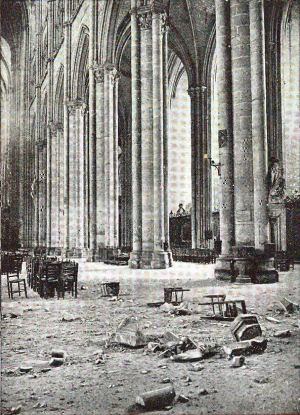 |
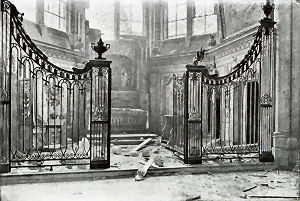
above: chapel of St. John the
Baptist damaged by a shell (left-hand side of apse)
|
related material:
Germans
in France
the
choir stalls of Amiens cathedral
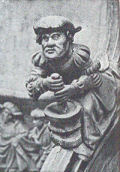 The
choir (chœur in French) is where the clerics
attached to the cathedral’s chapter (or religious
hierarchy) gathered during prayers and services. The
choir (chœur in French) is where the clerics
attached to the cathedral’s chapter (or religious
hierarchy) gathered during prayers and services.
The clerics were not allowed to sit in “the presence
of the Lord” and the ceremonies could continue for
hours on end. The priests and monks were allowed a concession
of a little ledge on which to rest their bottom while
appearing to be standing. These ledges are called misericords
(also spelt misericorde, misercord = mercy), and were justified by being the location
for fancy carving on religious topics or stories from
the bible.
The choir stalls at Amiens are considered to be among
the best anywhere. They certainly are splendid, but I
prefer the
choir stalls at Auch. They are an extraordinary treasure
hidden at the heart of that cathedral, with primitive
naive energy, both in the subjects and in their implementation.

Two choir stalls at Amiens cathedral
with their misericords marked.
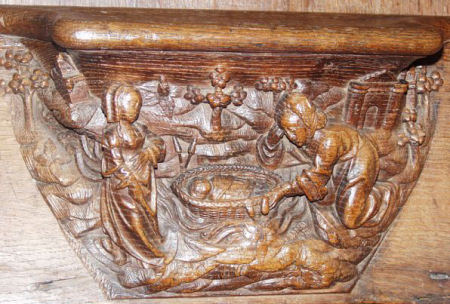
Misercord showing baby Moses being
found in a basket by the river Nile.

Feast of Cana carving on the side
of a choir stall.
The Amiens choir stalls were made between 1495-1530.
The artists were Arnould Boulin, Alexandre Huet and Jean
Trupin. More images of the stalls are available at princeton.edu. This
is the introductory page to Amiens. Many more choir stalls
can be viewed via drop-downs on this page.
|

Dating from the end of the 13th century
What a strong chin!
|
the stained
glass at amiens
 Amiens
cathedral has a stained glass collection of shreds and
shards ranging over several centuries and several styles. Amiens
cathedral has a stained glass collection of shreds and
shards ranging over several centuries and several styles.
The earliest glass, dating from the 1230s, showed the
various artistic fashions in the 13th century. This early
glass was the lowest glass in the nave; finished in 1236,
but destroyed at the end of the 13th century when the
side chapels were built. The few vestiges were scattered
in various depots and museums. The majority of this glass
was gathered together, organised and conserved in 1830
by the painter and glazier, M.-H. Touzet. The pieces were
placed in Bay 27 on the north side. There, they have been
reunited in a forced fashion in three lancets, with story
compartments, mostly from Genesis, arranged around a central
ornamental motif.
During the Middle Ages, the wealth of Amiens was based
on guède production and dying, becoming
the main centre in France. Guède was the
French name for woad, a blue dye originating from Isatis
tinctoria leaves. More recently, in France, it is
usually called pastel. The dye is used for clothing (French
Army uniforms and American denim jeans for instance) and
paints, among other things. Several Amiens worthies, who
had created their wealth through guède manufacture and trade, made donations towards the construction
of Amiens cathedral.
One of these donors, Andrieu Malherbe donated the glass
shown here to the right in 1296 [located in Bay 39]. Malherbe
was a rich burger of Amiens. He became mayor [maieur, mayeur] of Amiensin 1292, and died in 1293. His
first name was sometimes written as André, and
was also shortened to Drieu or Dreux. His wife was called
Maroie. His coat of arms carried a fleur-de-lys (semé
de France) on a ground of argent, with four azur
tortoises.
Drieu Malherbe had acquired in 1291, from the chamberlain
of King Philippe-le-Bel [1285 - 1314, father of Henry
IV of Navarre] for about 1,000 pounds, the right of tonlieu for guaide [guède] in Amiens.
In feudal law, the right to tonlieu is a tax
levied for the display of merchandise in the markets.
It is also a toll levied on goods transported across of
a river by bridge or by ferry, or through the gates of
the city.
Thus Malherbe could collect tolls and levees on the guède traffic and its revenues. These
amounted to about 550 pounds a year. Dreux Malherbe, who
died in 1295, left in his will to the town of Amiens,
this right to collect taxes on guède,
which produced a not inconsiderable income and was to
be distributed as alms and be used to found two chapels,
one in the church of Notre-Dame d'Amiens, the other in
the church of Saint-Nicolas and the Poor Clerks.
Amiens account registers show that the town paid annually
from the alms of Lord Drieu Malherbe:
To Saint-Ladre annually, on the day of Mid-Lent - 30
pounds
To the hospital in front of Saint-Leu, on Saint Jean-Baptiste’s
Day - 20 pounds
To the God of Amiens hostel, on the day of Mid-Lent
- 60 pounds
To the convent of minor brothers, the same day - 60
pounds
To the convent of preacher brothers, the same day -
30 pounds
To the chaplain of the chapel of the Poor-clerks, on
saint Christopher’s day - 30 pounds
To the chaplain of the Saint Agnes chapel in the Notre-Dame
church, on Saint Jean-Baptiste’s Day - 30 pounds
To the Mayor of Amiens as alms which he gave in great
blankets and shoes to the poor on Toussaint [1st November]
and the Day of Souls [2nd November] - 11 pounds
Derived from Le
Livre d'or de la municipalité amiénoise [The book of gold of the Amiens municipality], GoogleBook
pp. 40 - 41
and Le
premier livre des Antiquitez, Histoires et Choses plus
remarquables de la ville d'Amiens, poëtiquement
traité [The first book of Antiquities,
History and Things most remarkable of Amiens, poetically
treated] by Adrian de La Morlière, 1626 - p.318
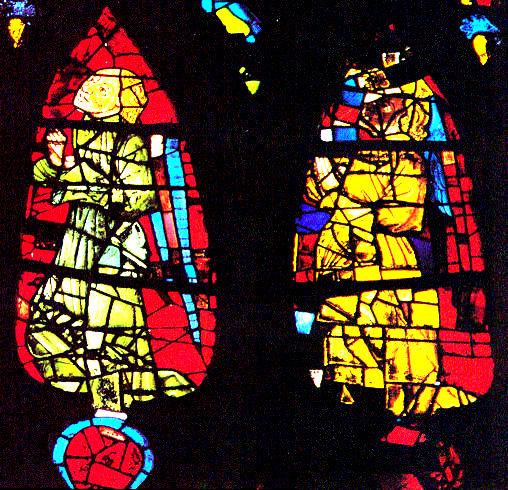
Two panels from the south rose window,
end of 15th to start of 16th century
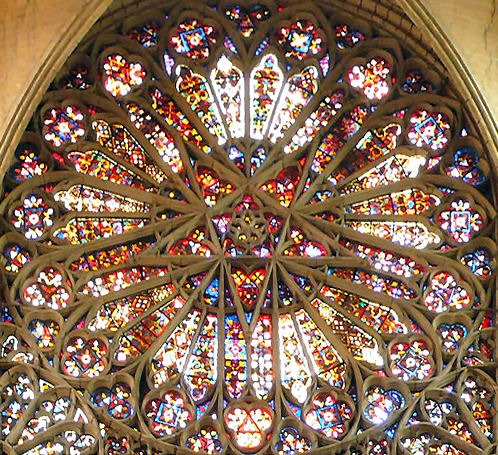
The transparency of the North transept rose,
with pentagon and pentagram centre
Common among Victorians was the fancy that the rose windows of a cathedral like Amiens somehow incorporated magical reference to the four ancient elements of earth, fire, air, and water - a bit strained when you have to cram the four elements into three rose windows. To skid around this inconvenience, the west window was deemed to incorporate both earth and air. The north window was more easily associated with the transparency of water, while the south window could be associated with the darker reds and oranges of fire.
The standard colours of the four elements were attributed as earth>green; air>yellow or perhaps grey, white, or blue; fire>red or orange; and water>blue. As you can see, there is a bit of a struggle with the colours of air, though the others are fairly conventional.
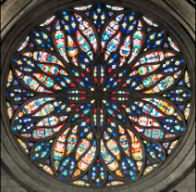 |
 |
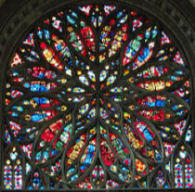 |
| Amiens cathedral west rose |
Amiens cathedral north rose |
Amiens cathedral south rose |
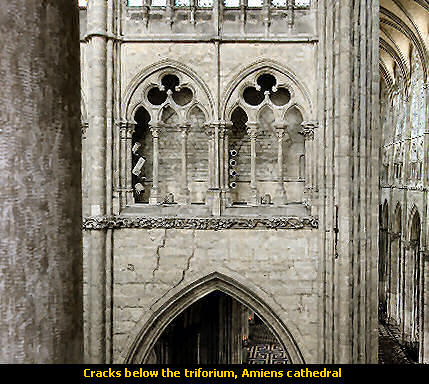
buttressing and chainage
To help protect the cathedral from literally falling apart from the strains generated by building such a large structure that led to it being rather unstable, chains of iron stabilising rods [chaînage, chainage] were added, generally hidden galleries and passages.
The building of Amiens cathedral, a huge cathedral only capped in height by Beauvais, was much effected by the then nascent knowledge of structural engineering, and by the ambitions of the builders and the people who commission the construction. The flying buttresses were not always sufficient, or were not placed to apply a counter pressure in the right position to prevent the stone shifting so cracks appear, columns to bow and arches threaten to collapse.
To correct the problems that appeared, the builders at Amiens took two main steps. One was adding better positioned buttressing. The original flying buttresses had been placed so their point of reinforcement was too high, and so not effective. Additional buttressing was added later to correct the problem.
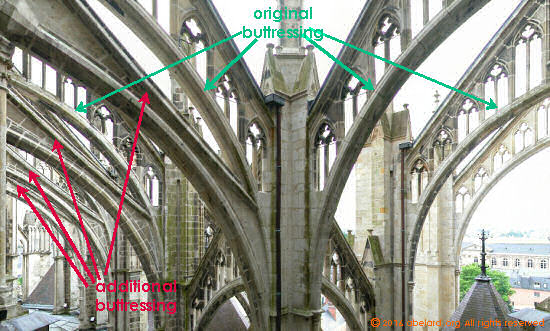
Above and right: Double buttressing at Amiens
|
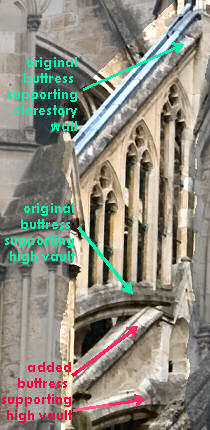 |
|
| |
The original buttressing to the south-east crossing of the transept and nave are among the most beautiful of any cathedral, and were designed to support both the clerestory wall and the high vaults. Unfortunately, the artistry outran the technology. The lower part of the buttress (marked in green) was placed slightly too high to give sufficient support to the vaults, necessitating an added lower reinforcing buttress (marked in red) in some places. The extra buttress somewhat spoiled the original artistic effect.
The second method for correcting the cathedral's structural problems was giving the cathedral a girdle, at first in wood. This was later replaced with an iron armature, probably forged at the Abbey of Fontenay.
| Background
facts |
Amiens |
- approximate population : 133 354
average altitude/elevation : 33 m
-
Amiens is 87 miles/139 km north of Paris
-
- cathedral dimensions
- external length : 145 m
internal length : 133.5 m
transept external length : 72 m
transept internal length : 62 m
transept width : 29.3 m
nave width : 12.15 m
nave height (under the vaults) : 42.3 m
tower height, to top of spire : 112.7 m
labyrinth (labyrinthe) diameter : 12.1 m
|
|
| |
 Jesse tree window at Beauvais Jesse tree window at Beauvais |
 Beauvais
- The cathedral of St Peter Beauvais
- The cathedral of St Peter
It is a while since I visited Beauvais, and what was
seen has become somewhat impressionistic. Beauvais cathedral
rises like some volcano or primitive dinosaur that has
burst forth from the earth among the houses of the town.
The dominant response I have is ‘scary’,
and that’s just from the outside. The outside isn’t
interesting or very remarkable beyond its great explosion.
But go inside, and until recently, you stepped into a
threatening cauldron, shorn up by an array of iron and
wood. This is the real monster of gothic cathedrals, the
choir vault rising to over 46 metres, that’s over
150 feet. This extraordinary elevation is further emphasised
by the fact that the nave is so short, having never been
completed. There’s no long nave to balance the rocketing
height.
The cathedral may have survived the WW2 incendiary bombardments
that razed much of Beauvais, but this frail stone house
of cards is still at the mercy of man and nature. Gale
force winds originating from the English Channel oscillate
the buttresses and shift the weak roof structure, while
sometimes ill-conceived repairs and restorations to the
structure. Running from the 1950s to the 1980s, one experiment
involved removing many important iron ties from the choir
buttresses. This damaging project was thought to have
been corrected by temporary ties-and-braces in the 1990s.
However, this may have made the building too stiff, so
increasing stresses rather than diminishing them.
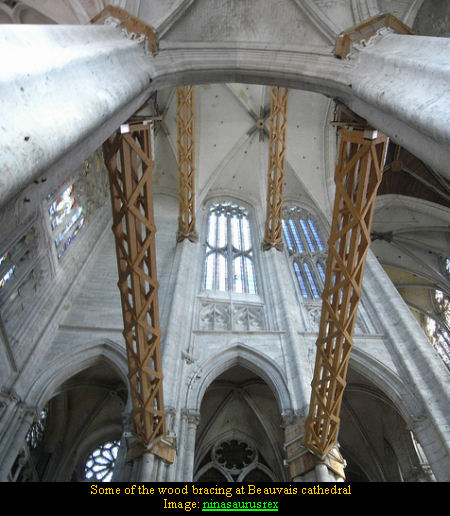
But since 2010, this has changed after major consolidation
works were effected, stabilising the heights of the nave.
This stabilisation is even leading to the notion that
perhaps the tower and spire could be re-erected, this
time successfully.
some
history and interesting facts
The cathedral, with its five-aisled choir abutted by
a towered transept, was commissioned by Bishop Milon de
Nanteuil in 1225. It was opened in 1272.
The vaulting fell in 1284.
The tower/spire was completed in 1569.
- Four little turrets were supported by the four pillars
of the transept crossing.
- The turrets rose from the roof and met a square,
open tower forty-eight feet high [14.6
m].
- A second tower, octagonal, lace-like, and sixty-three
feet high [19 m],
- The second tower supported a third stage, over forty-nine
feet high [15 m], which was still more lightly
traceried.
- These three divisions more than a hundred
and sixty feet high [49 m] were made of stone,
- and on them rested the ninety-seven foot high [30 m] wooden needle.
- The entire spire rose two hundred and fifty-seven
feet [78 m] above the roofs of the Cathedral
and nearly five hundred feet [152 m] above the ground.
“This new pyramidal spire became the wonder
of the country. "It ... was ... higher than the
famous spire of Strasbourg, and it is said that from
its summit, the houses of Paris were visible."
”
[Cathedrals and cloisters of the Isle de France vol. 2 by Elise Whitlock Rose, pp.293-4]
The tower fell in 1573.
“On the eve of Ascension Day, 1573, a few small
stones began to fall from its heights. The next morning,
a mason, who had been sent to test it, cried out in
alarm; the bearers of the reliquaries, about to join
the Procession of the people and the clergy who were
waiting outside, fled;—there was a violent cracking,—and
in an instant, the vault crashed amidst a storm of dust
and wind. Then, before the eyes of the terrified worshippers,
the triple stories of the lantern sank [like the Twin
Towers on 9-11-2001], the needle fell, and a shower
of stones rained into the church and on the roofs.”
[Cathedrals and cloisters of the Isle de France vol. 2 by Elise Whitlock Rose, pp.296-7]
There is no record of what became of the mason!
It’s almost a shame to go into details rather than
just let the cathedral overwhelm your senses, a bit like
discussing the size of the wheels on a roller coaster.
If the medieval mind ever wished to put you in awe whilst
adding a touch of real-world danger, this is it.
The ominous reason that Beauvais was never completed
is that the original enthusiasts just could not be quite
sure of making it stay up!
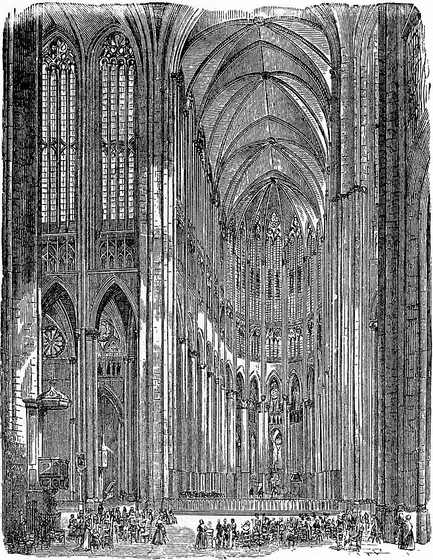
The interior of Beauvais cathedral,
from Grundriss der Kunstgeschichte,
1864
Note the tiny people at the base of the soaring columns |
|
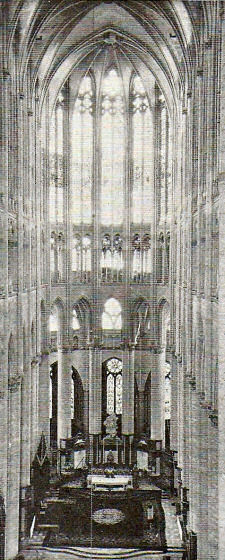
Notice the unusual four levels of windows in this towering cathedral |
All the parts in this vast edifice are derived from
the equilateral triangle, from the floor plan to the
both the overall design and the details of the cross-sections
and elevations. Unfortunately, the cathedral of Beauvais
was erected with too limited resources and weak materials,
as well being provided with a too narrow site. The various
messes, stemming from bad work by unskilled workmen,
necessitated repair and consolidation work, as well
as the doubling of the piers. This last destroyed in
great part the truly prodigious impression made by the
immense nave, so well conceived theoretically and drawn
by a man of genius.
It was the custom and sometimes, as in this instance,
the tragedy of those days, for builders to use the stone
of the region or of some donated quarry, irrespective—and
sometimes in spite—of its quality. This was part
of Beauvais's tragedy. If Beauvais had not been commenced
at a time when the religious and political movement
which had built the Northern Cathedrals had begun to
lose impetus, Saint Peter’s cathedral would have
stood. If the architect had possessed the quarries of
Burgundy, the materials used at Dijon and at Semur,
or the beautiful calcareous stone of Chatillon-sur-Seine,
or even that of Montbard, Austrude, or of Dornecy, or
even—which might have been possible—that
of Laversine, of Crouy, and certain hard strata of the
valleys of the Oise or the Aisne, the work would have
stood. [including abstractions from Viollet Le-Duc vol. VII,
p.549]
Beauvais:
World War 2 damage
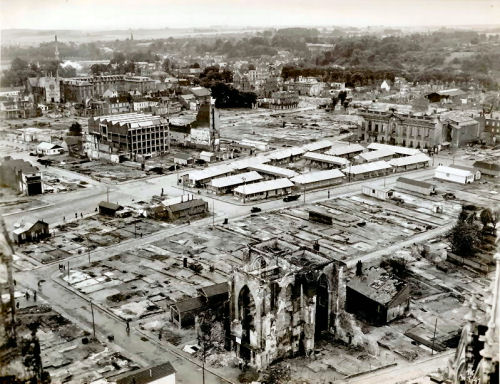
Beauvais after German bombing in 1940. The cathedral is
in the foreground.
Early in June 1940, there was several days of heavy bombing.
The Luftwaffe set most of the medieval town alight. Many
were killed, while the tapestry industry was devastated
and a 42,000 book library burnt out.
"In Beauvais, a number of the metallic tie-rods supporting the flying buttresses bear graffiti from the eighteenth century, potentially indicating that the metal may have been a later addition. However certain pieces proved to date back to the beginning of the construction process (around 1225-1240 AD), suggesting that in order to succeed in erecting the world's highest Gothic choir (46.3 meters), iron was combined with stone from the initial design phase."
 The Germans smashed Beauvais cathedral in 1940, as can be seen in this image. The upper flying buttresses were destroyed (see right). The Germans smashed Beauvais cathedral in 1940, as can be seen in this image. The upper flying buttresses were destroyed (see right).
Therefore, I am unsure quite what is being claimed here. Maybe some of the bars had been recovered from the rubble.
related material:
Germans
in France |

above and below:
thirteen century glass at Beauvais cathedral

|

A great gothic cathedral is akin to a house of cards.
The great west front and the marching bays of the nave
form a bulwark against the weight of the crossing and,
likewise, the apse at the eastern end. Beauvais in its
incomplete state is unusual, it has no great west front,
no west doors or portals. This is part of why the stability
of Beauvais is somewhat dubious.
glass at
Beauvais
Fortunately, most of the important glass at Beauvais
was removed to safety before the devastation
caused by National Socialism’s Luftwaffe.
The great doors of Beauvais are north and south. Like
much of the cathedral, the transepts containing these
doors date from the sixteenth century and the two great
roses are, therefore, flamboyant.
The north rose is sometimes described as a sun, and rises
above a series of lancets showing sibyls. The south front
has two rows of lancets probably representing kings and
prophets, and is surmounted by a rose that divides into
stories from the Old Testament. It has God at the centre,
surrounded by the seven days of creation and then outside
that, Adam, Noah, Babel, Abraham and Isaac, Joseph, Moses
and the flight from Egypt. At present, I can find no good
illustrations for these roses among my photographs, nor
on the web.
There is generally more academic interest in the medieval
glass, from the 13th, 14th and even 15th centuries. For
example, there are six very nice thirteenth-century lancets
in the apsidal chapel. Their draftsmanship is unusually
good. Pictures of two can be seen at the head
of the Beauvais section, and a couple more next to
this section.
A brilliant book on the early Beauvais glass is Picturing the celestial city by Michael Cothren. This book is expensive, but unlike
most coffee table books, the text is good, coherent and
interesting from beginning to end. It is copiously and
appropriately illustrated. I can recommend this book unreservedly.
Your public library should have a copy, even if you decide
it is too expensive. (This book also does not cover the
later glass.) 
I can also recommend Painton Cowen’s brilliant
and growing catalogue
of stained glass windows for those wishing to have
an idea of the glass in the great churches - this
is the link to the Beauvais section. There are links
to other parts of the site available to the left side
of the page. (For Painton
Cowen’s book.)
| Background
facts |
Beauvais |
- approximate population : 53,400
average altitude/elevation : 65 m / 213 ft
Beauvais is 53 miles/84 km north of Paris
-
- cathedral dimensions
- total length : 70 m / 230 ft
tower height : 151.59 m / 497.3 ft
choir vault height : 46.77 m / 153.4 ft
great arcade height : 21.2 m / 69.6 ft
great bay height: 17 m / 56ft
triforium height : 4 m / 13 ft
nave width : 16 m / 52 ft
transept length : 58 m / 190 ft
diameter north rose : 11 m / 36
diameter south rose : 11 m / 36 ft
|
bibliography
Picturing
the celestial city by Michael W. Cothren
 |

|
Princeton University
Press, hbk, 2006
ISBN-10: 0691120803
ISBN-13: 978-0691120805
$79.86 [amazon.com]
£66.45 [amazon.co.uk] {advert}
|
|
The Early Iconography of the Tree of Jesse
by A Watson |
 |
Oxford University Press
1934, hbk
4to., pp.xiv,197,(xl), navy cloth, gilt, b/w frontispiece, 40 b/w plates to rear of volume |
|
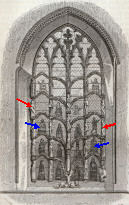 |
In Living Memory: Portraits of the Fourteenth-Century Canons of Dorchester Abbey
by Lucy Freeman Sandler
Nottingham Medieval Studies - 56():pp. 327-349 [22 pages]
BrepolsOnline, Brepols Publishers NV
This publication is sold as a .pdf download of a journal article.
An individual can have "unlimited access" for $22.00 plus tax ($1.21), a total of $23.21.
"To gain access to your content, please go to: www.brepolsonline.net, log on to your account and navigate to your purchased content. If you have questions regarding this purchase, or require additional help, please contact us at Brepols Publishers NV" |
end notes
- The Bible of Amiens by John Ruskin, 1884, chapter 4, p.378.
The
Bible of Amiens is available on the web as
part of a collection. There, it extends from p.273 to
p.412. It is also available on paper in reprints (make
sure you are buying the full version with four chapters)
and secondhand copies.
Chapter 4, starting on p.362 of the online version,
contains a minute description of the statuary of Amiens
cathedral, complete with symbolic meanings.
John Ruskin (1819-1900) spent several years in Amiens,
referring to Amiens cathedral as the “Parthenon
of France”.
The great cathedrals are often referred to as ‘bibles
in stone’, and here you can see Ruskin’s
analysis of the Amiens statuary in that spirit.
- On the inscription, 1288 is written
“Xiij.c ans moins XII”, or “13
hundred years less 12”.
Note that on the copper plaque from the cathedral, the
Roman numerals are written in the normal way as XIII.
The transcription in John Ruskin’s book writes
Roman numerals as was commonly done since medieval times,
with the final ‘i’ of a number group being
written as a ‘j’as a terminator. On medical
prescriptions, the terminating ‘j’ helps
avoid prescribing errors.
Thus, the first ten Roman numerals would be written
j, ij, iij, iv, v, vj, vij, viij, ix, x.
- Tree of Jesse
- A visual representation of the genealogy, the family
tree, of Jesus. The name ‘Jesse Tree’
comes from the Book of Isaiah 11:1, where Jesus is
described as a shoot coming up from the stump of Jesse,
the father of David.
In stained glass depictions, the tree comes from the
side, or the navel, of Jesse lying on a bed. The lineage
shown includes the following list, but may be longer,
including other ancestors such as Solomon.
The characters in the list below of a typical Jesse
tree are accompanied by symbols, which may decorate
the Jesse tree. Bible sources are also included.
Adam and Eve, symbol : apple
(Genesis 2:4-3:24)
Noah : ark or rainbow (Genesis
6:11-22, 7:17-8:12, 20-9:17)
Abraham : knife (Genesis
12:1-7, 15:1-6)
Isaac : ram (Genesis 22:1-19)
Jacob : ladder (Genesis
27:41-28:22)
Joseph : colourful coat (Genesis
37, 39:1-50:21)
Moses : tablets of the law
(Exodus 2:1-4:20)
David : harp (1 Samuel 16:17-23)
Isaiah : lion and lamb (Isaiah
1:10-20, 6:1-13, 8:11-9:7)
Mary : lily (Luke 1:26-38)
Elizabeth : small home (Luke
1:39-55)
Joseph : hammer or saw (Matthew
1:18-25)
- Grundriss
der Kunstgeschichte, 1864, by Wilhelm Lübke
(1826-1893), p.388, fig.227.
-
The hedgehog, elsewhere, is described as an urchin, the bird as a cormorant, a heron, a pelican, or even an owl. Such are the problems in translating from two or three thousand years ago. For a wide-ranging list of translations, see Zephaniah 2-14, and let this be a lesson to you.
[The hedgehog quatrefoil is located at the bottom right of the Saint Fermin door, the north portal of the Great West door.]
- It is traditional to name the doors by the person whose statue is on the trumeau. The south portal is Our Lady. The central portal of the west front is God, who has a small statue of Saint Peter under his feet.
|
















 Jesse tree window at Beauvais
Jesse tree window at Beauvais


"In Beauvais, a number of the metallic tie-rods supporting the flying buttresses bear graffiti from the eighteenth century, potentially indicating that the metal may have been a later addition. However certain pieces proved to date back to the beginning of the construction process (around 1225-1240 AD), suggesting that in order to succeed in erecting the world's highest Gothic choir (46.3 meters), iron was combined with stone from the initial design phase."
 The Germans smashed Beauvais cathedral in 1940, as can be seen in this image. The upper flying buttresses were destroyed (see right).
The Germans smashed Beauvais cathedral in 1940, as can be seen in this image. The upper flying buttresses were destroyed (see right).


![]()

